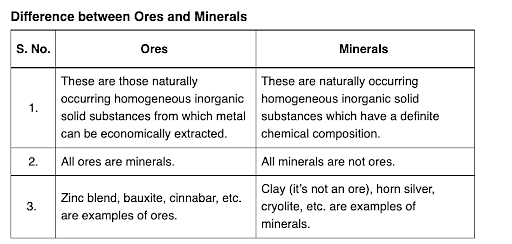Match list I with list II
List I
List II
A Siderite I Aluminum B Malachite II Iron C Calamine III Copper D Bauxite IV Zinc
Choose the correct answer from the options given below:
Match list I with list II
List I | List II | ||
| A | Siderite | I | Aluminum |
| B | Malachite | II | Iron |
| C | Calamine | III | Copper |
| D | Bauxite | IV | Zinc |
Choose the correct answer from the options given below:
A-I, B-II, C-III, D-IV
A-II, B-III, C-IV, D-I
A-IV, B-III, C-II, D-I
A-III, B-II, C-IV, D-I
The Correct Option is B
Solution and Explanation
the correct answer is: A-II, B-III, C-IV, D-I.
Top Questions on General Principles and Processes of Isolation of Elements
- What is used for the Thermite Reaction?
- BCECE - 2025
- Chemistry
- General Principles and Processes of Isolation of Elements
- Which of the following compounds is used to cover the surface of a metallic object to prevent corrosion?
- KEAM - 2025
- Chemistry
- General Principles and Processes of Isolation of Elements
A block of mass 1 kg is pushed up a surface inclined to horizontal at an angle of \( 60^\circ \) by a force of 10 N parallel to the inclined surface. When the block is pushed up by 10 m along the inclined surface, the work done against frictional force is:

[Given: \( g = 10 \) m/s\( ^2 \), \( \mu_s = 0.1 \)]
- BITSAT - 2024
- Physics
- General Principles and Processes of Isolation of Elements
- Two spheres A and B having respective charges 6 C and 12 C placed at a distance \( d \) repel each other by a force \( F \). The charge given to sphere A to reverse the force as \( -F \) is:
- KEAM - 2024
- Physics
- General Principles and Processes of Isolation of Elements
- A particle of mass \( 2 \) kg is on a smooth horizontal table and moves in a circular path of radius \( 0.6 \) m. The height of the table from the ground is \( 0.8 \) m. If the angular speed of the particle is \( 12 \) rad/s, the magnitude of its angular momentum about a point on the ground right under the center of the circle is:
- BITSAT - 2024
- Physics
- General Principles and Processes of Isolation of Elements
Questions Asked in CUET exam
Rearrange the following parts to form a meaningful and grammatically correct sentence:
P. that maintaining a positive attitude
Q. even in difficult situations
R. is essential for success
S. and helps overcome obstacles effectively- CUET (UG) - 2025
- Sentence Arrangement
- Rearrange the parts to form a logical sentence:
A) the city's new policy
B) has significantly improved
C) air quality
D) over the past year- CUET (UG) - 2025
- Sentence Arrangement
- A train crosses a platform 200 m long in 36 seconds and a pole in 18 seconds. Find the speed of the train.
- CUET (UG) - 2025
- Speed, Time and Distance
- In a certain code language, "MOTHER" is coded as "OMHTRE". What will be the code for "FATHER"?
- CUET (UG) - 2025
- Logical Reasoning
- Two like charges are placed 1 m apart in air. If the force between them is 9 N, and one charge is 1 C, what is the other charge? (Use $ k = 9 \times 10^9 \, \text{Nm}^2/\text{C}^2 $)
- CUET (UG) - 2025
- Electrostatics
Concepts Used:
General Principles and Processes of Isolation of Elements
What are Ores and Minerals?
Minerals are the naturally occurring, homogeneous inorganic solid substances. They are having a definite chemical composition and crystalline structure, hardness and color. For example, copper pyrite, calamine, etc.

Impurities in an ore are called gauge. The removal of a gauge from the ore is called concentration ore.
Several steps are involved in the extraction of pure metal from ores. Major steps are as follows –
- Concentration of the ore
- Isolation of the metal from its concentrated ore
- Purification of the metal